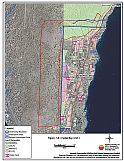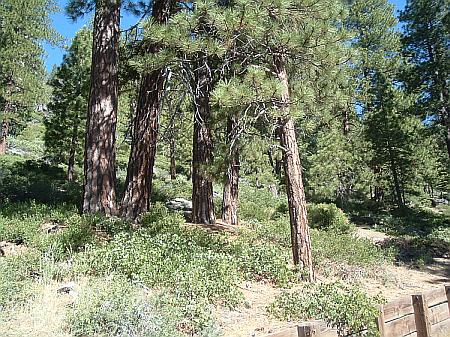Risk/Hazard Identification and Mitigation Project Worksheet
Name of Community: Crystal Bay
Date: July, 2004
Project Title: Crystal Bay Unit 1 - Thinning and Brush Removal
Description of Risk/Hazard: Describe in detail the risk or hazard that poses a threat to the community.
Vegetative Fuel and Topography: The Crystal Bay Unit 1 is characterized by a dense forest stand of Jeffery pine and white fir. There is an abundance of dead and down woody material and steep slopes above the homes in the Crystal Bay area. A heavy brush understory exists in, around, and above homes.
Worst Case Scenario: A fire that starts on the California side of the Nevada/California state line could spread into the homes in Crystal Bay, driven by the wind and topography, and fueled by dense understory vegetation. The fire would eventually ladder into the tree crown.
Priority Ranking: What is the priority ranking of this risk/hazard in relation to all others identified?
The dense, untreated fuel loadings and wind driven fire behavior scenarios make this project the #1 priority for the NLTFPD.
Location: Describe or attach a map with sufficient detail to allow accurate ground location.
Above the Crystal Bay community, illustrated on Figure 7-8
Recommended Mitigation Measures and Scope of Work: Present prescription and work specifications in sufficient detail to facilitate procurement of bids and quotes. For hazardous fuel removal projects include estimated volumes (tons/acre) of fuel removed and disposal plan.
Remove or thin brush understory to decrease the fire intensity and reduce ladder fuels. Spacing between remaining bushes should be 2-3 times the height of brush. A brush masticator could be used where slopes are 30% or less, though few areas are less than 30% slopes in this prescription area. Grind the brush and leave as mulch, or hand cut, pile, and burn. Use of herbicide could reduce sprouting of some species.
Establish a shaded fuel break within the Wildland Urban interface (WUI). The fuel break would be situated upslope and west of private land in Crystal Bay for ¼ mile. Thin from below, removing smaller trees and leaving larger ones to achieve the desired stocking rate of 80 to 100 square feet of basal area per acre.
*Prescribed fire could be used to reduce the brush understory, and is the desired treatment where feasible to return fire to the landscape. It should only be applied in areas after thinning and slash pile burning are complete to maintain fire control
Evaluation of the Extent to Which Completion of This Project Will Reduce the Fire Threat:
Thinning trees and opening the tree canopy while removing understory shrubs and small trees (ladder fuels) will reduce the threat of an uncontrolled crown fire burning into the homes of Crystal Bay and threatening SW Incline Village. Treatment in this area will help contain human-caused ignitions below the project area, keeping them from spreading uphill and becoming uncontrollable fire events.
If all of the recommendations in this report are implemented, there is still no guarantee that a devastating wildfire will not occur in the Crystal Bay area. However, community awareness and individual attention to fuels management on private property and fuel reduction on state, federal, and county property will help to achieve the highest level of wildfire safety possible.
Identification of Protected Species or Other Critical Resources: Describe any measures that must be taken to protect critical wildlife habitat, historic
Environmental compliance measures must be implemented before project initiation. Stream Environment Zones are located in the project area and must be protected, employing appropriate TRPA mitigation measures.
Some threatened and endangered species exist in the Tahoe Basin. Appropriate avoidance and mitigation measures should be employed during project implementation.
Compliance with cultural resource protection may also be necessary. Check with TRPA and the NVSHPO to ensure cultural resources are protected.
Post-project Rehabilitation: Present scope of work in sufficient detail to facilitate procurement of bids and quotes.
Rehabilitate any fire control lines, landings or disturbed areas. Rehabilitation will be minimal if only hand methods are used. Where soil has been disturbed, TRPA rehabilitation measures and Best Management Practices would apply. This could include reseeding or mulching areas if necessary.
Estimated Timeline:
Desirable time of year to complete:
May - December
Estimated time required to complete project:
Two operational seasons.
Estimated Cost: Present an estimate of the total cost of project completion and the basis for the estimate presented. If the project can be subdivided into phases or various components, present an estimated cost for each.
Cable yarding is recommended, however, no costs for cable yarding were available. The costs below are a minimum based on currently accepted methods in the Tahoe Basin.
| Hand cut, pile, and burn | $2,000 / acre X 161 acres | |
| Prescribed fire within 5 years | $1,200 / acre X 161 acres | |
| Total Cost | $ 531,200 |
Project Maintenance Requirements:
Re-thin in 15-20 years.
Re-burn at ten-year intervals or less. Prescribed burn within five years after cut, pile, and burn.
Other Considerations: Describe any other considerations that must be taken into account to successfully complete this project such as permits, clearances, approvals, etc.
- TRPA Tree Removal Permit
- State (NDF) Tree Harvest Permit
- State (NDF) Stream Zone Variance
- Air Quality Permit (Washoe County)
- NEPA Compliance (LTBMU)
Figure 7-8Proposed Prescription Area Crystal Bay Unit 1 |
 |

